-
Car Reviews
- All reviews
- Midsize SUVs
- Small cars
- Utes
- Small SUVs
- Large SUVs
- Large cars
- Sports SUVs
- Sports cars
- Vans
Latest reviews
- Car News
-
Car Comparisons
Latest comparisons
- Chasing Deals
It’s nicer, pricier and sportier, but does the WRX for devotees muster up any of that old-school STI magic?
Kudos to Subaru for bucking modernisation pressures to persist with an old-school WRX recipe for gearhead buyers with traditional tastes and whims.
The “rally derived” mantra might not hold the dirty, oily water it once did, but the pitch remains, pumping a decades-old turbo-boxer lifeblood through “symmetrical all-wheel drive” convention.
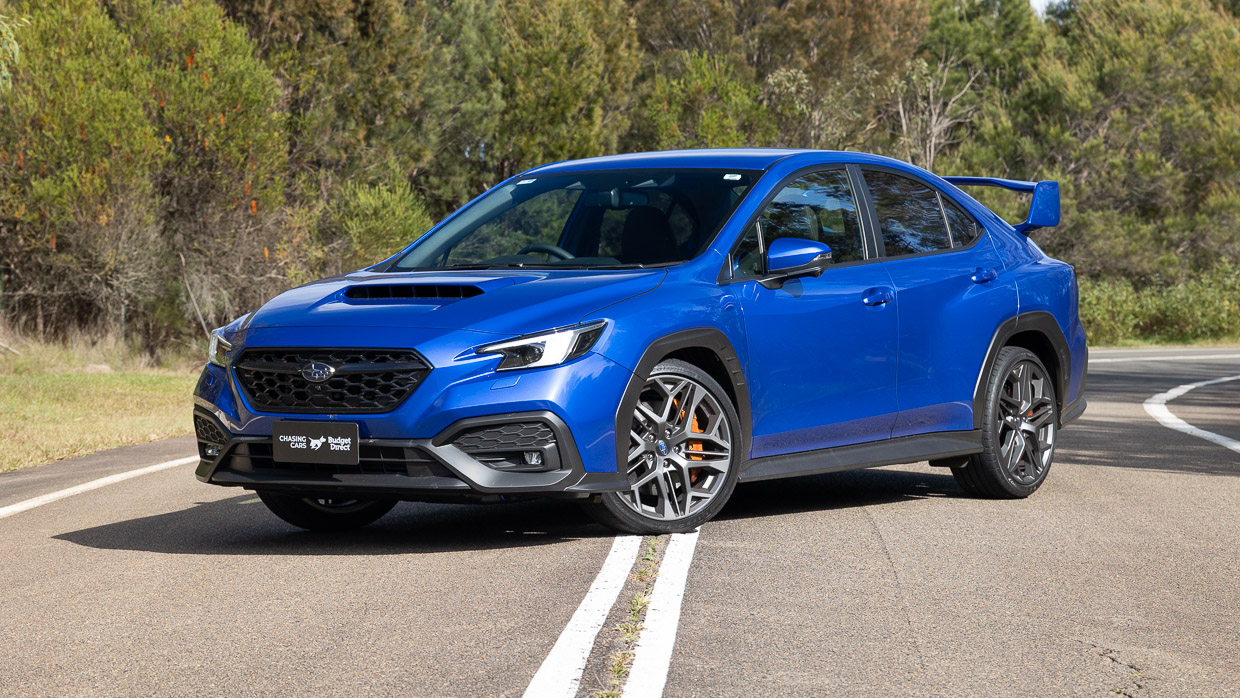
However, the properly hot STI machines are no more, with Subaru sadly — if wisely — putting the hallowed nameplate on hiatus years ago when the rally-homolgated DNA that defined ‘true STIs’ dropped off the recipe as the Japanese carmaker’s formal rally ties subsided.
In 2025, we’re left with the WRX AWD tS Spec B as a missing link of sorts.
Framed as the nicer, sportier, most-STI-alike enthusiast special of the erstwhile MY24 line-up — there’s a caveat coming — it’s positioned as the closest thing to truly bottling good-old noughties all-paw rally-inspired fun factor…without the proper rally-bred STI credentials.
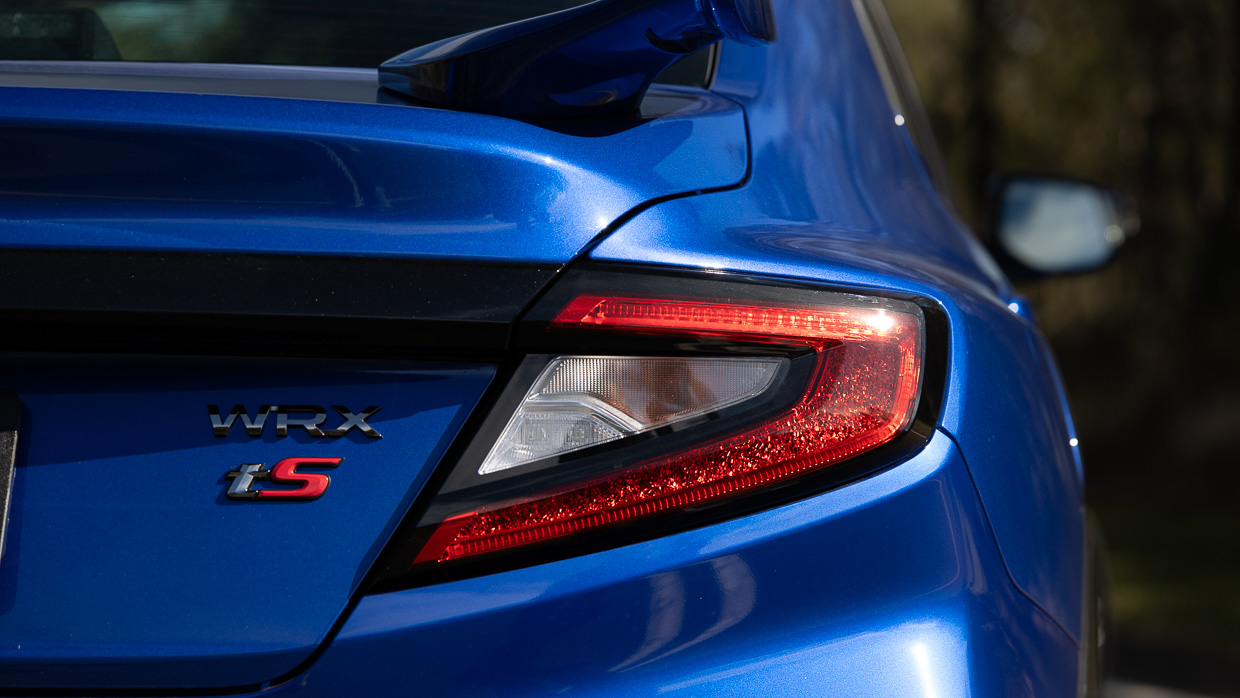
One that’s modernised just enough to slip through contemporary road-going emissions, safety and tech auspices. Is it any good? Is it anything like a classic STI experience? And is it worth its premium? Let’s find out…
Launched in March this year, the tS Spec B variant exclusively brought 19-inch wheels, high-performance Bridgestone rubber, big six-piston Brembo brakes, a circa-2005 rear wing, a 12.3-inch digital instrument cluster and rig-hugging Recaro front bucket seats to the now nine-variant-strong WRX line-up.
And at a palatable $61,490 before on-roads.
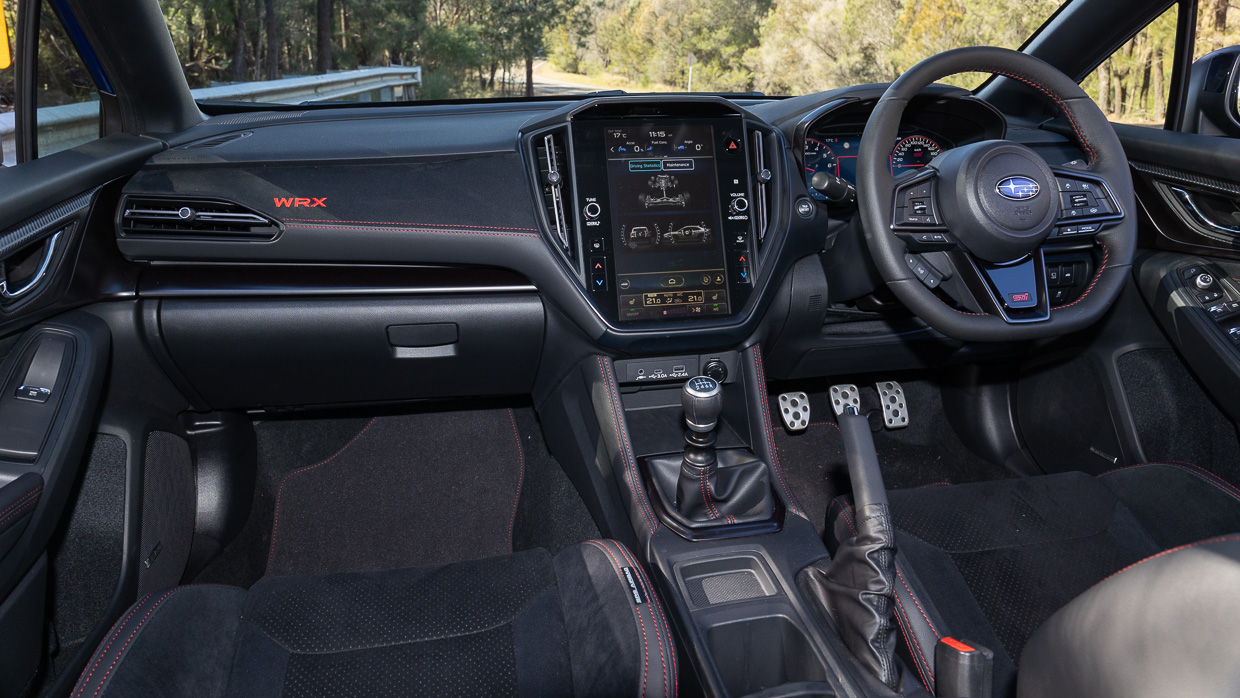
A month after the Spec B debut, Subaru announced an updated MY25 WRX line-up, that went on to add the once-exclusive Recaros and 12.3-inch driver’s screen to all three tS — short for ‘Tuned by STI’ — sedan and Sportswagen variants, robbing the Spec B of a couple of key unique selling points.
Crucially, the tS Spec B remains the only WRX version offering both a six-speed manual transmission and electronically adjustable suspension dampers paired with Drive Mode Select.
The bad news? At 202kW and 350Nm, it’s the same 2.4-litre boxer used elsewhere in the WRX line-up, so no higher outputs.
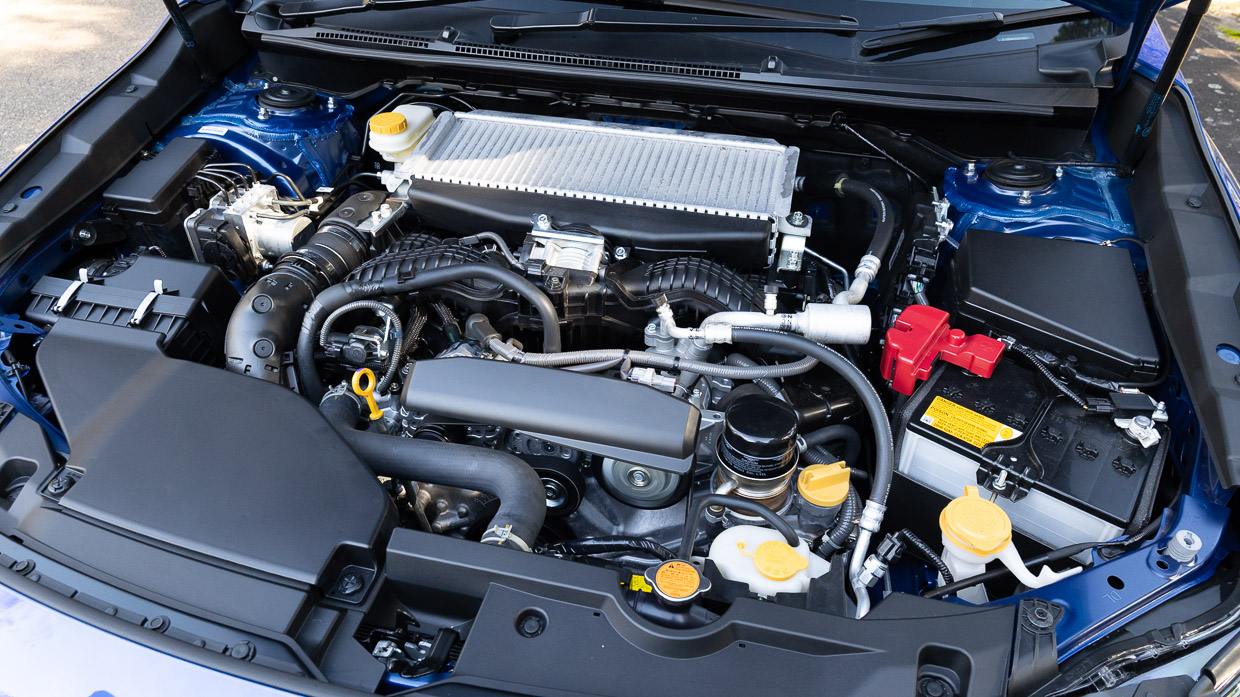
And, sadly, there’s no ‘Sportswagen Spec B’ as yet — all five-doors maintain the Lineartronic CVT auto, a powertrain that also misses out on the manual sedan’s viscous centre LSD.
All of this leaves the Spec B variant no quicker than the regular — and $13,300 more affordable — manual WRX sedan and with precious little in the way of inimitable specification outside of rolling stock, questionable boot appendage and adaptive dampers.
WRX tS Spec B features include:
An STI Performance muffler is available on the Spec B as a no-cost option and possibly best considered essential fitment. The Spec B also debuted Subaru’s Eyesight suite-paired Emergency Driving Stop driver monitoring system.
Five no-cost colours are available, including a new Galaxy Purple Pearl that replaces the now defunct Solar Orange Pearl option. The RS grade’s standard-fit sunroof is omitted from the pricier Spec B as this, according to Subaru, helps to “reduce weight and optimise performance”.
Having reviewed umpteenth WRXs — regular and STI, Impreza-branded or not — since the late 1990s, your reviewer considers the gen-two ’GD’ bug-eye STI the high watermark, with a gradual decline in form ever since.
Bar special editions, the breed generally got woolier, more wooden and less connected as time went on, regardless of hiked outputs or specifications added.
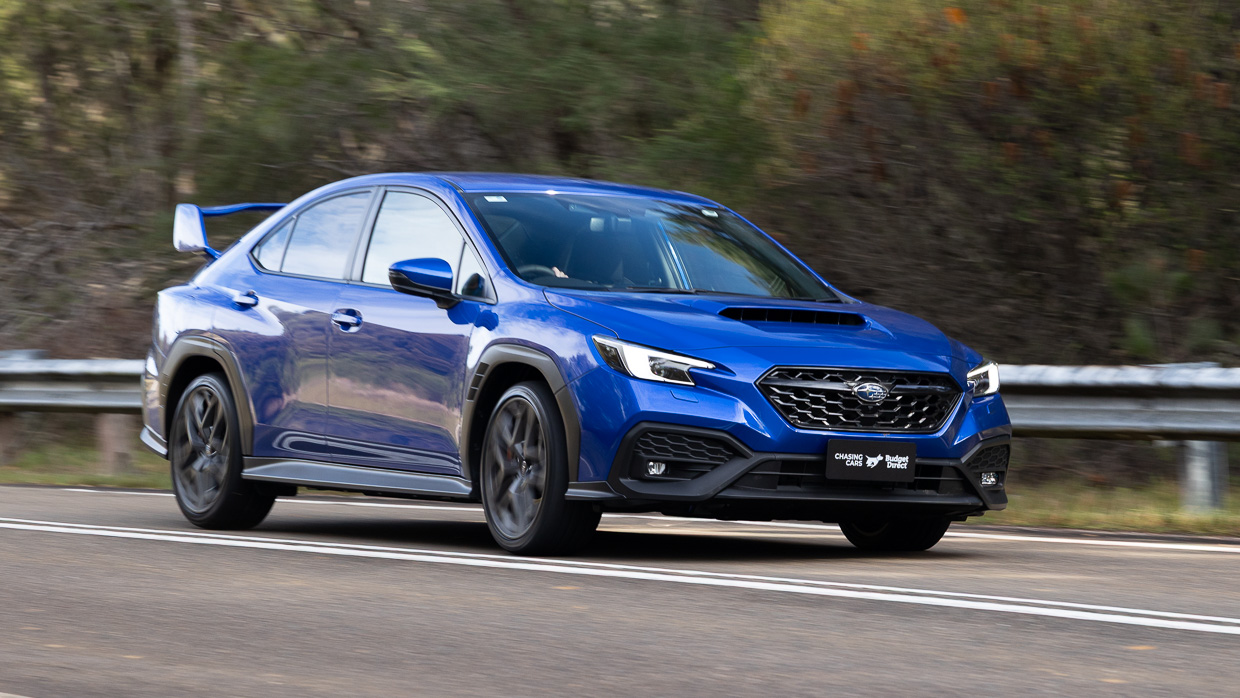
So, boy, the tS Spec B is quite a surprise. It’s very good, partly because it’s quick, partly because it’s got a real sting in its tail, but mostly because it’s about the most integrated and synchronous performance package I can recall in a regular WRX…pretty much ever.
Still, it’s not a proper STI by another name. Even if, in some areas, it gets pretty close.
At 202kW and 350Nm, today’s 2.4L boxer outpunches the old bug-eye’s (harder-strung) 2.0L on the numbers. And at 1522kg, the Spec B is probably just as quick — interestingly, Subaru makes no acceleration claims for its 2025 champion grade.
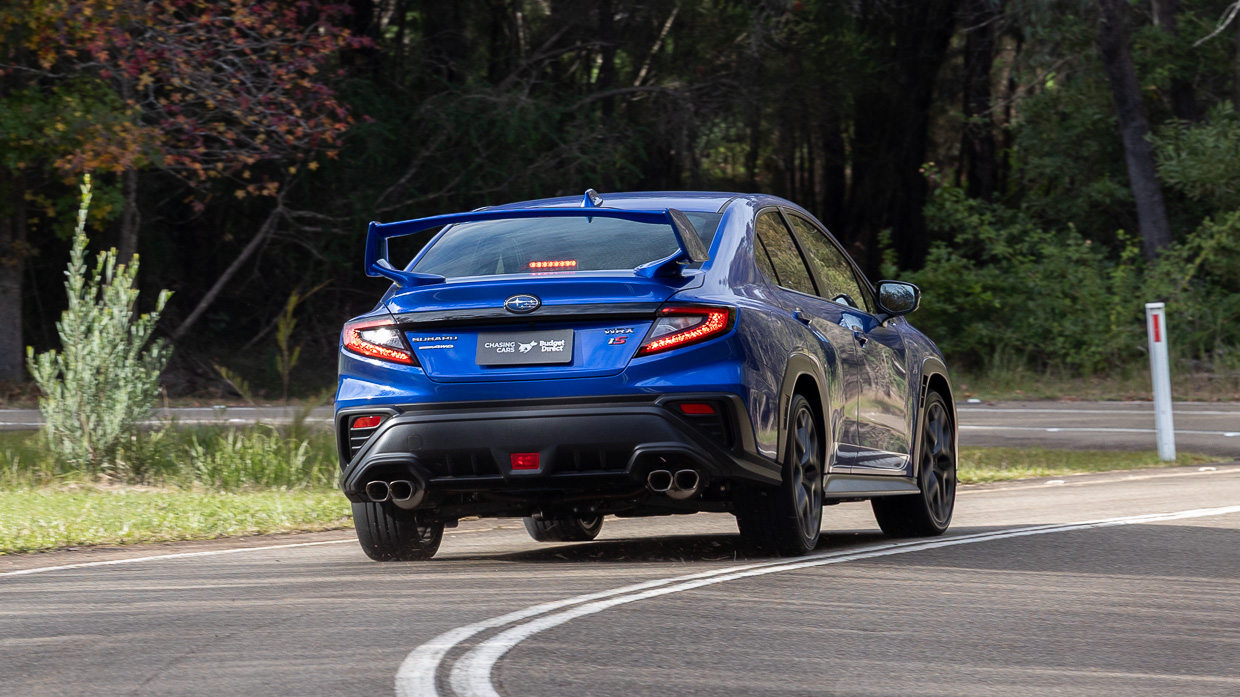
So STI-like potency is there, but where this particular boxer shines is in tractability. Where so many boxer forebears lacked low-rpm inertia — prone to stalling unless you’d prod the throttle off the mark — this 2.4 has natural torque off idle that ramps up nicely to where its peak starts at 2000rpm.
Paired with a strong if progressive clutch, it’s easy to move slowly or swiftly off the mark, its short 4.4:1 final drive bringing punch and purpose on tap.
With its short throw, tight gates and positive nature — real shades of older STI transmissions — the six-speeder feels slick enough for serious action and tough enough to withstand clutch dumping theatrics if the driver sees fit.
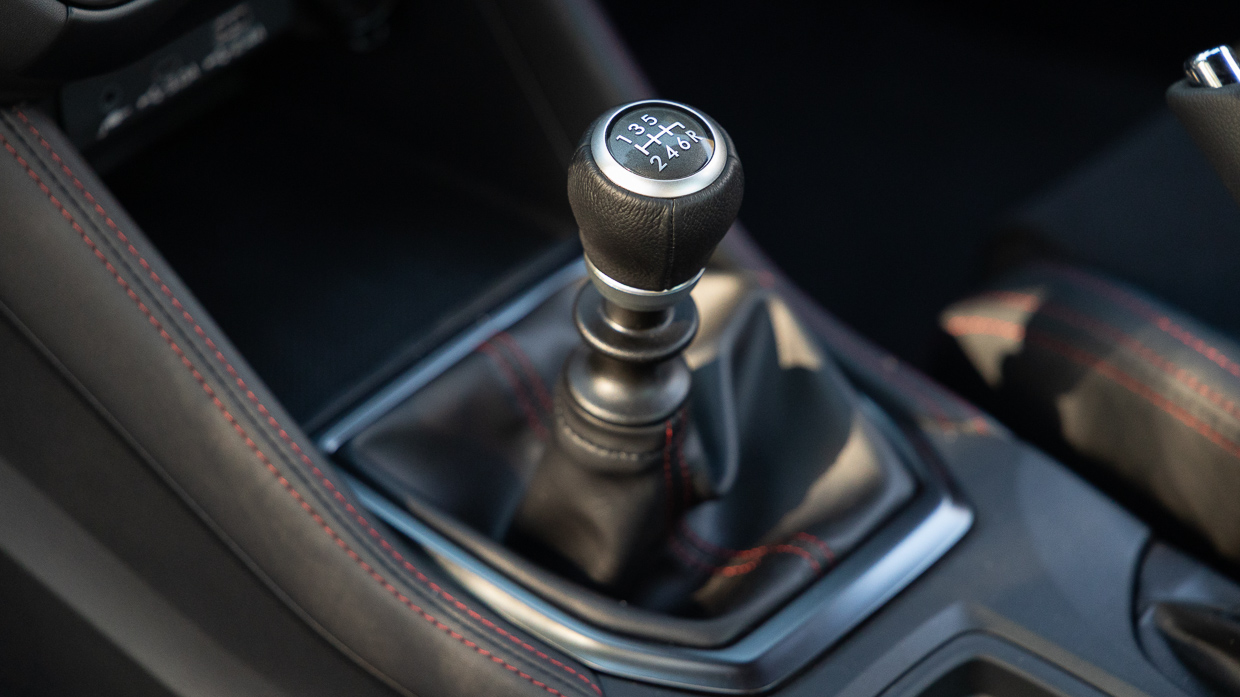
This taut, terrific, almost STI-lite powertrain nature is matched nicely to the strong, progressive feel of the six-piston Brembos.
These anchors feel vastly superior to even some older STI spec, which could lack bite and retardation power. There’s definitely a newfound, honed fitness to this WRX formula.
The theme continues to the steering. Too leaden in Sport calibration if more fluid and nicely measured in with higher Comfort assistance.
And the direction finder is paired with a front end that does a fine job of milking serious — and progressive — dry-running grip out of licorice-thin 35-series Pontenza S007 tyres.
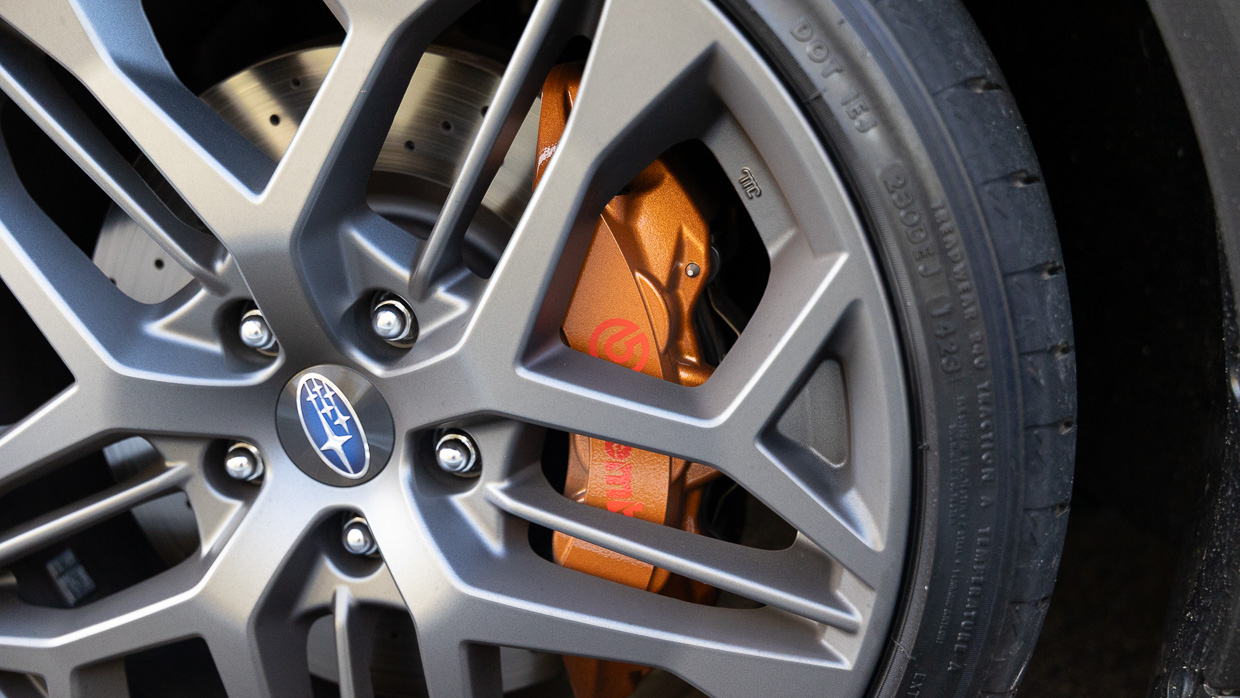
There’s natural balance, too, in the chassis, with both axles firmly in sync, drumming up an innate sense of control and precision at the helm.
Again, there’s a genuine synergy to the Spec B’s dynamic elements well above the old WRX norm — it not only makes this variant hugely driveable but confidence inspiring when you really grab its scruff hard.
Once you do, it’s wickedly quick and plenty of fun. The ‘walk’ it delivers certainly lives up to the boy- or girl-racer aesthetic the Spec B flaunts.
And when you do overstep the tyre friction, the combination of the viscous centre differential and torque vectoring smarts do a fine job of channeling the torque to the corner of the chassis that needs it the most.
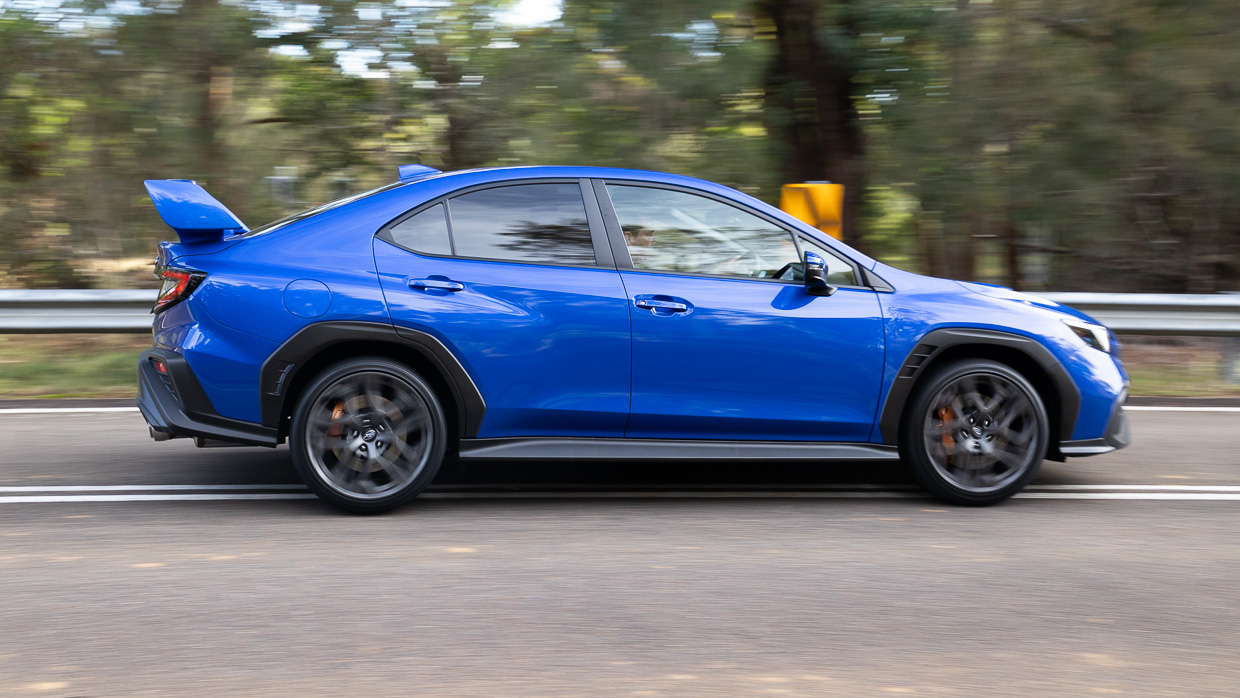
But…the bond-fide STI heroics are missing. The old Torsen axle differential and DCCD (driver controllable centre differential) trickery, that would make the chassis really come alive once you broke traction and grip on any surface, sealed or slippery, just aren’t parts of this regular WRX’s DNA.
As a firebreathing proposition, the Spec B has its technical limitations.
The real surprise is the ride comfort. The Spec B defaults in start-up in Sport, and the firmest of three damper settings. Even then, one member of the Chasing Cars crew who drove it remarked on how compliant it was around town.
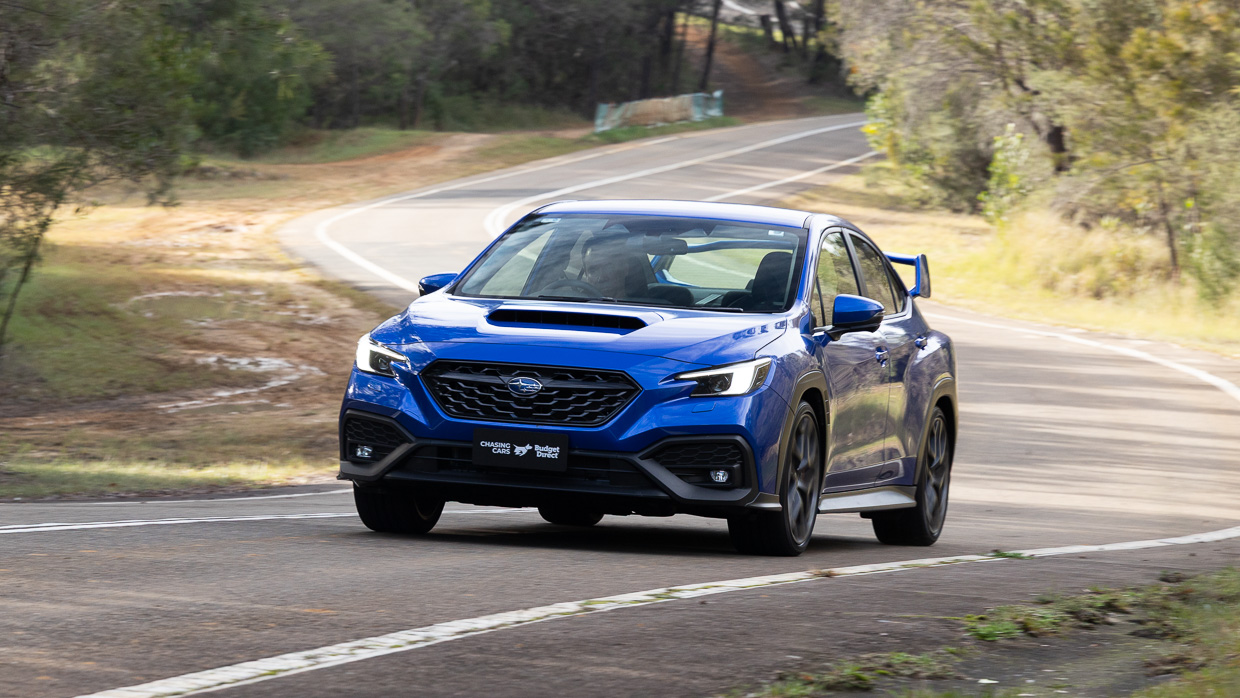
Set to its softest setting, this WRX has — without intended exaggeration — nicer ride comfort than half of the SUVs I’ve reviewed over the past few years.
The cooperation and sheer drivability of the powertrain combined with the exceptionally pleasant around town and touring manners really do make the Spec B, in particular, possibly the finest all-rounder ever to wear an WRX badge.
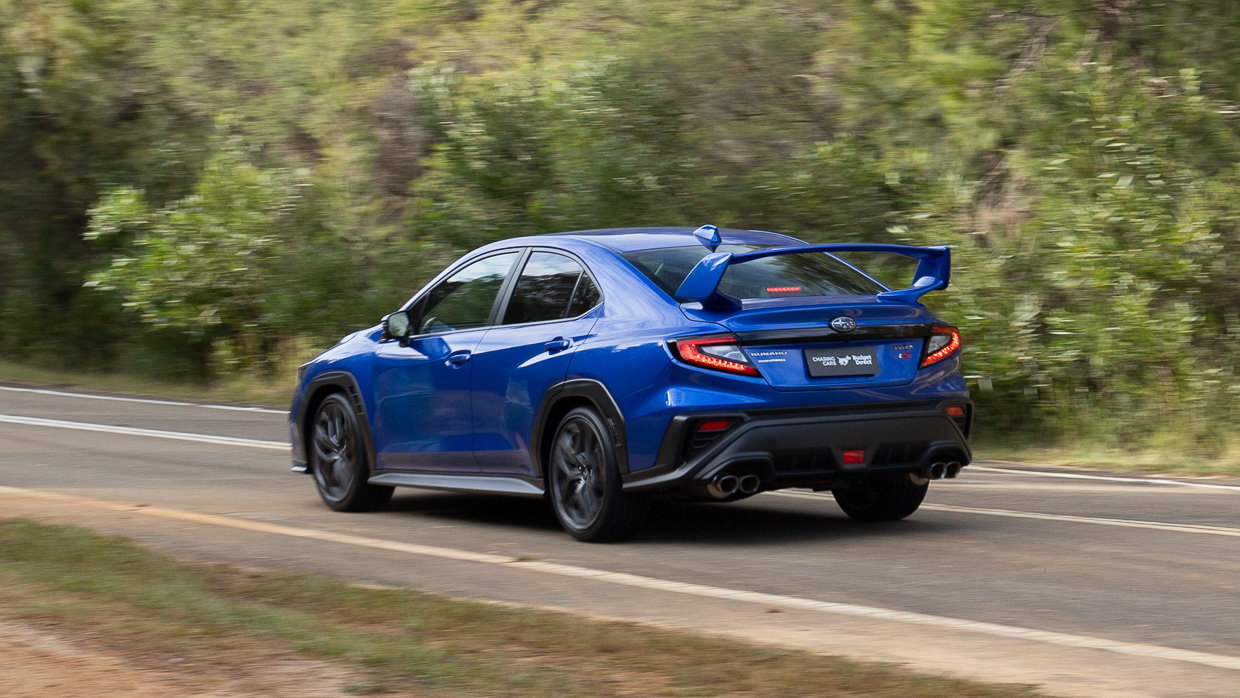
While the preferred ‘attack mode’ essentially taps Sport for powertrain and suspension tuning while resorting to Comfort for steering, the ‘everything soft’ Comfort drive mode preset makes the Spec B incredibly easy to live with — much more so than terser alternatives in the Hyundai i30 N or Honda Civic Type R.
In fact, the Spec B’s manual-and-adaptive suspension combination is such a sweet Jekkyl and Hyde that it’s a real shame that Subaru doesn’t choose to offer it in a more family-friendly five-door Sportswagon form.
The classic, old-school charm that today’s 2025 WRX carries on road continues through to the cabin, for better and for worse.
The fitment of Recaro-branded bucket seats has been a go-fast flex for Subaru (and other Japanese makers) dating back decades, so often to a result that feels more simply bolted in than properly ergonomically integrated by design.
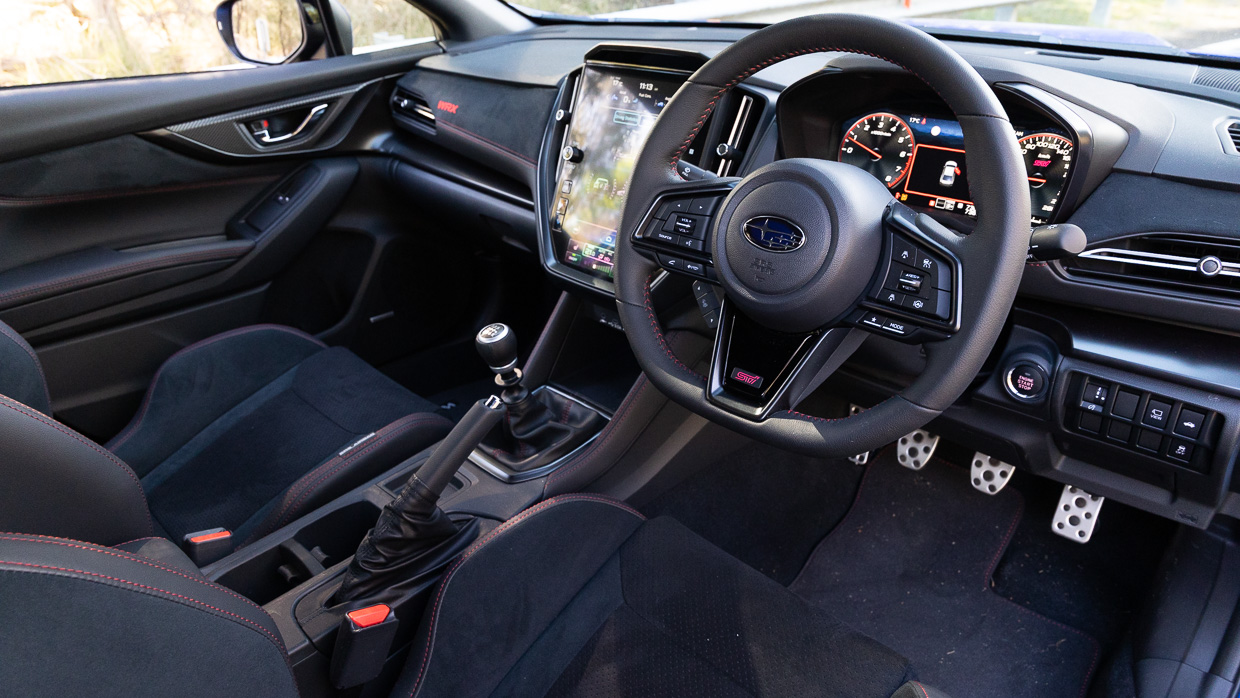
That’s the case here — they’re not quite a glove fit for the cabin — though issues are perhaps with the seats themselves.
These seats are unforgiving, wedging your thighs and welding your ribs with bolstering. The bases are short, lacking under-thigh support and, worse still, the seat backs are incredibly stiff.
They’re just form-fitting enough to alleviate the need to visit a chiropractor after a long Sunday morning b-road punt…just.
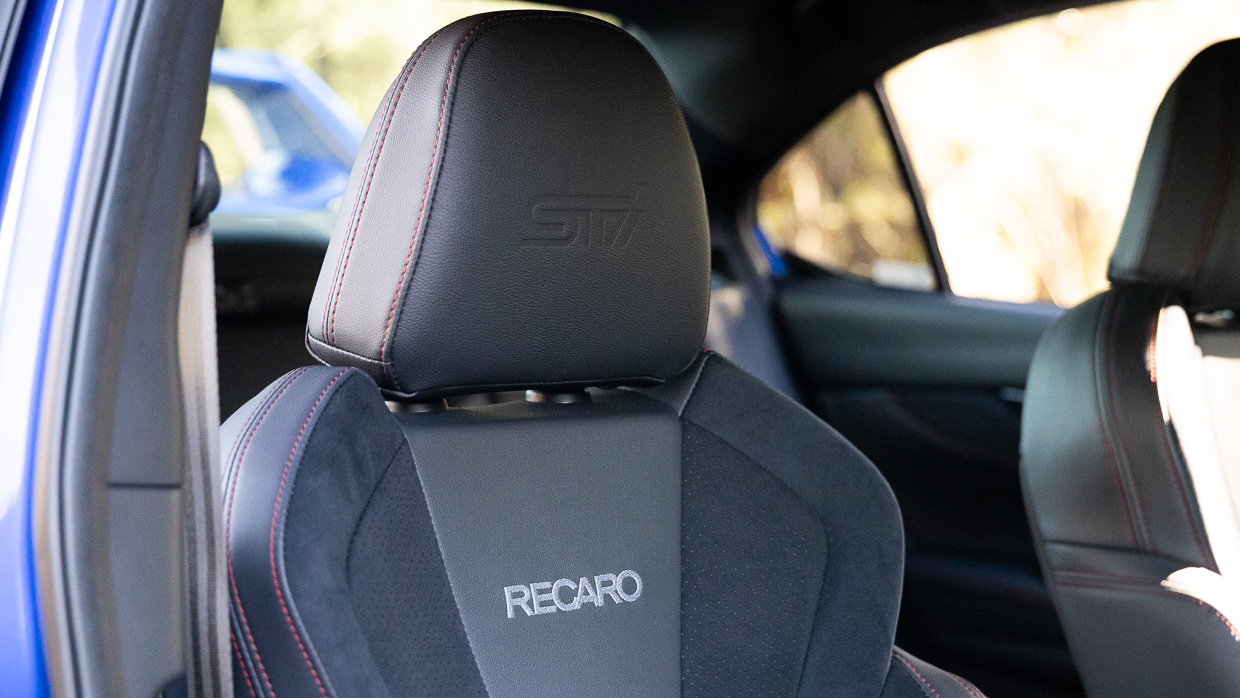
Elsewhere, the design ethos could be a decade old, though no Subaru model is a pillar of contemporary slickness or minimalism. At least it feels familiar and oh-so traditional WRX.
The new-for-WRX 12.3-inch driver’s screen brings some brightness to the darkened near-black cabin theme, which is at least punctuated with splashes of faux suede, not-really-carbon-fibre detailing and stacks of red double stitching.
But sharpness, skin design and content aren’t the driver’s screen’s strong points.
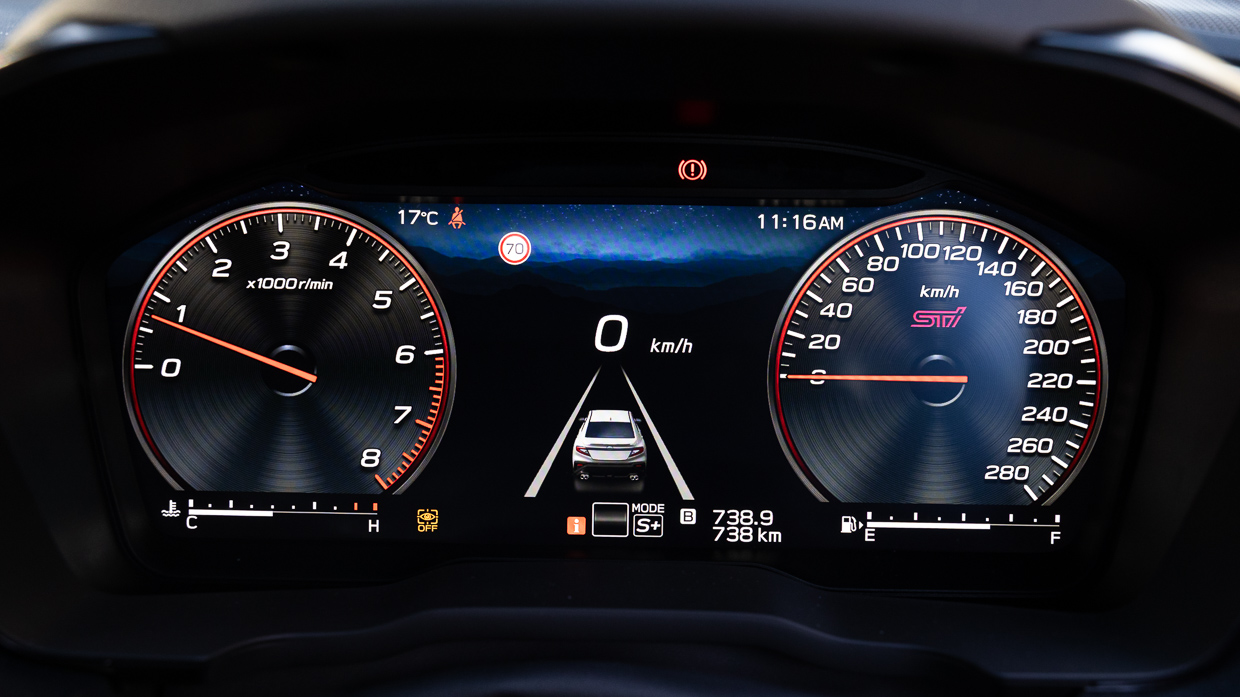
Ditto the 11.6-inch touchscreen. As is Subaru tradition, the display is overly busy and consumed with a dizzying array of different fonts as the media system attempts to bombard the occupants with all manner of inconsequential information (degrees of vehicle tilt, anyone?).
At least the physical audio dials and climate control buttons in the media screen frame are oh-so convenient to use.
The content is good. Wireless Apple CarPlay worked faultlessly — though wireless phone charging is absent — and the Harman Kardon sound is impressively rich and clear.
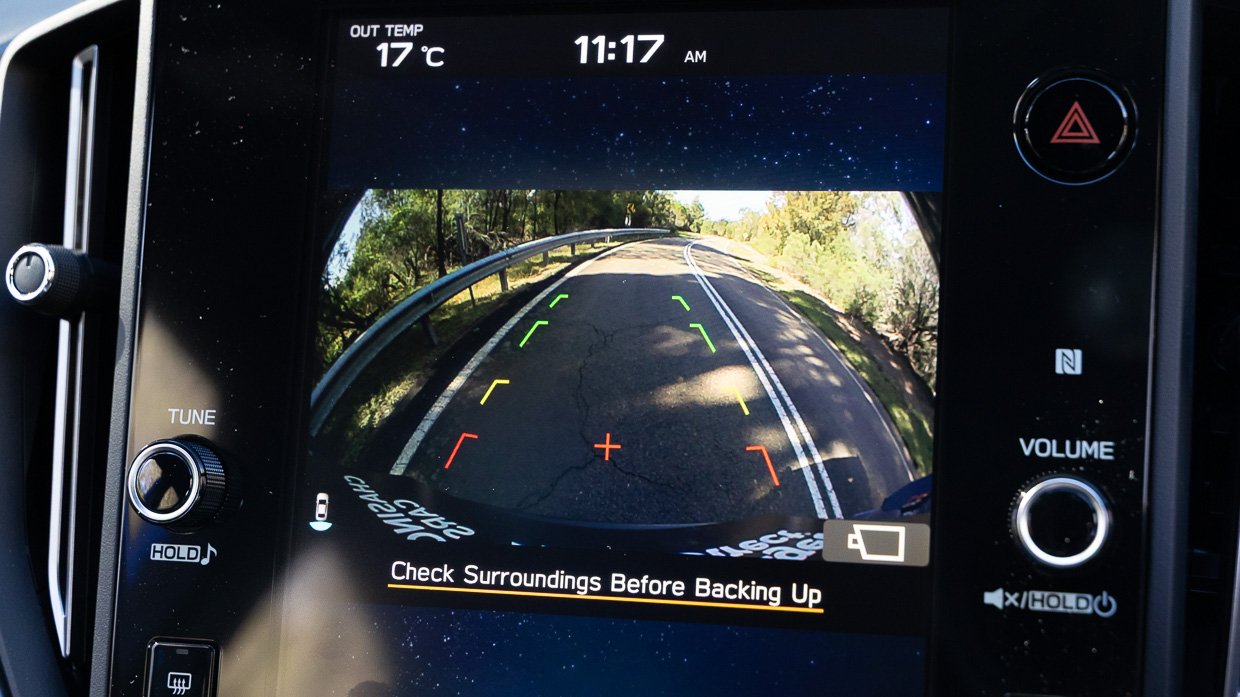
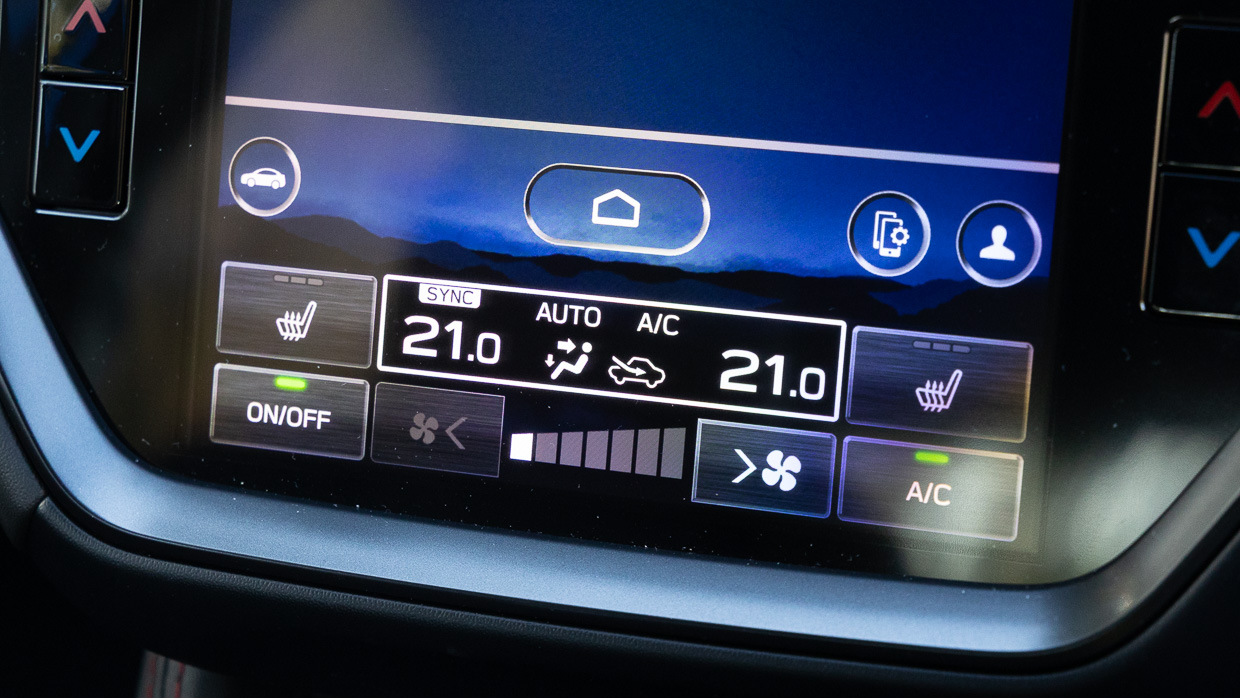
The reverse camera is also decent, though a lack of reversing sensors (or rear AEB) on manual WRXs specifically is a bit of a head-scratcher.
The 17-button multifunction wheel looks lifted from an Outback and the lack of a sportier, bespoke tiller is a bit of a missed trick.
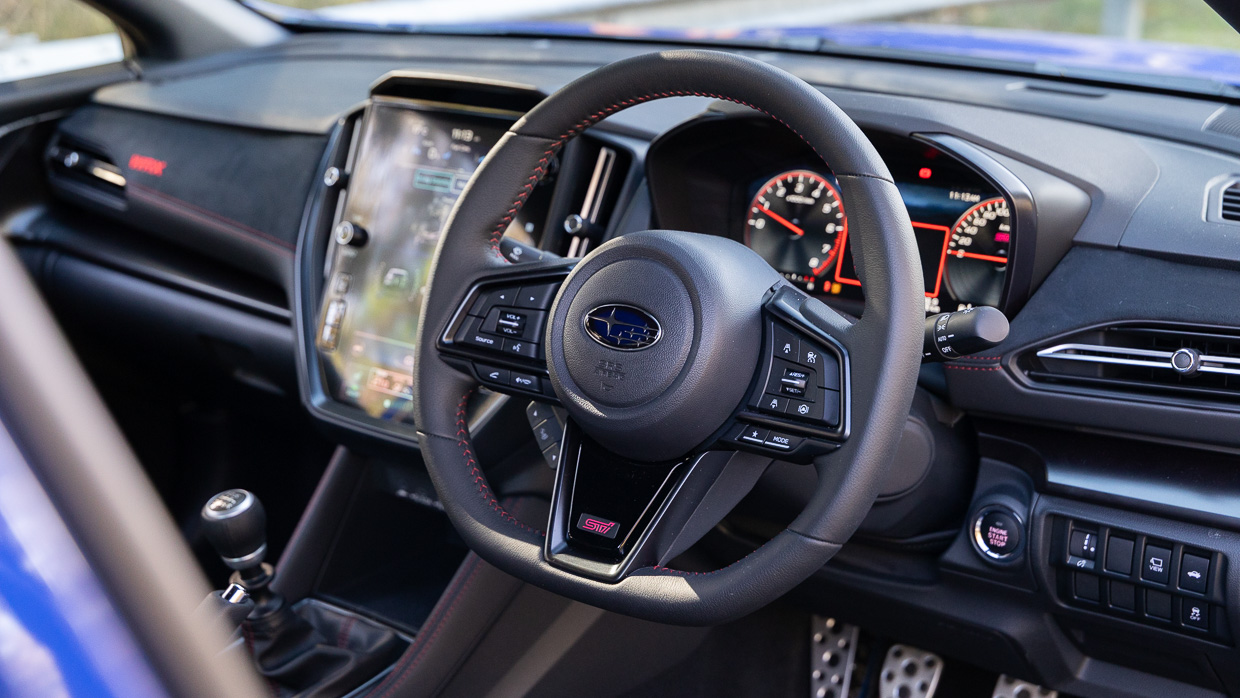
But it remains fit for the heat of the driving battle, right down to the good-old mechanical parking brake that’s a handy ally during motorkhanas and track work.
Row two offers plenty of legroom and feels spacious, though the ceiling lacks the concave depression found up front and as a result — and despite the lack of a sunroof — headroom is quite limited.
But rear occupants do benefit from decent amenities shared with those in the first row, including dual USB ports, flocked doors bins and seat heating, though yet another strange omission is a lack of rear air vents (otherwise fitted to the wagons).
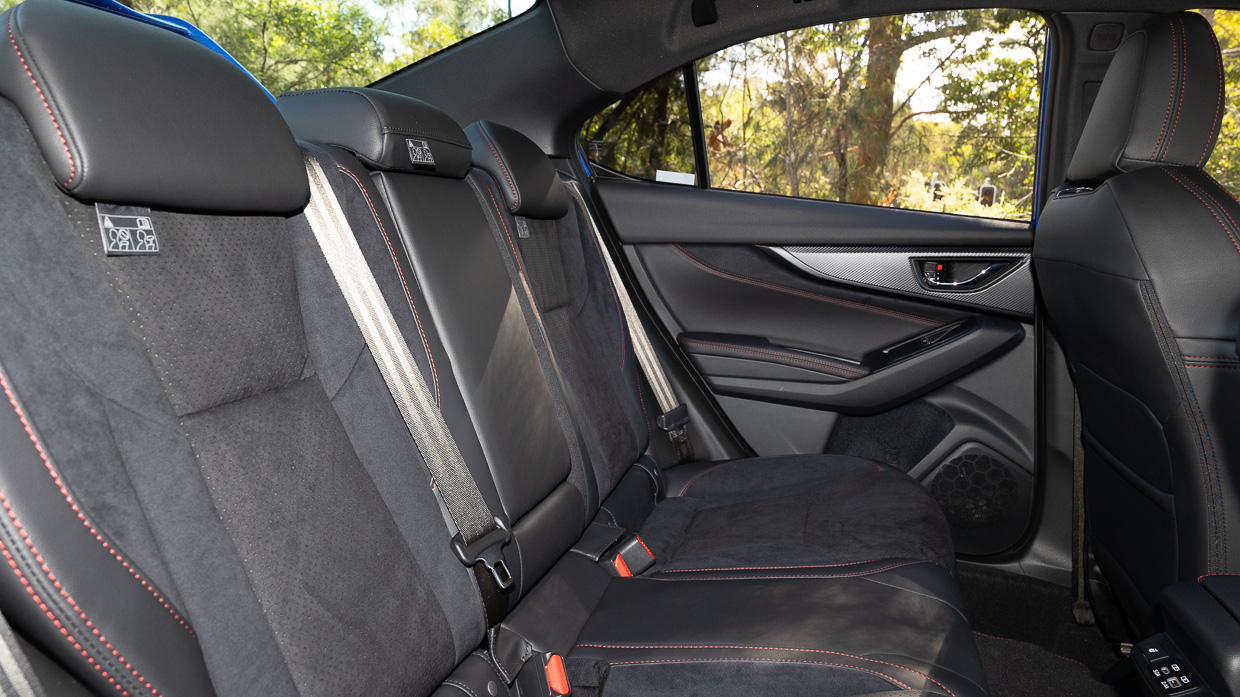
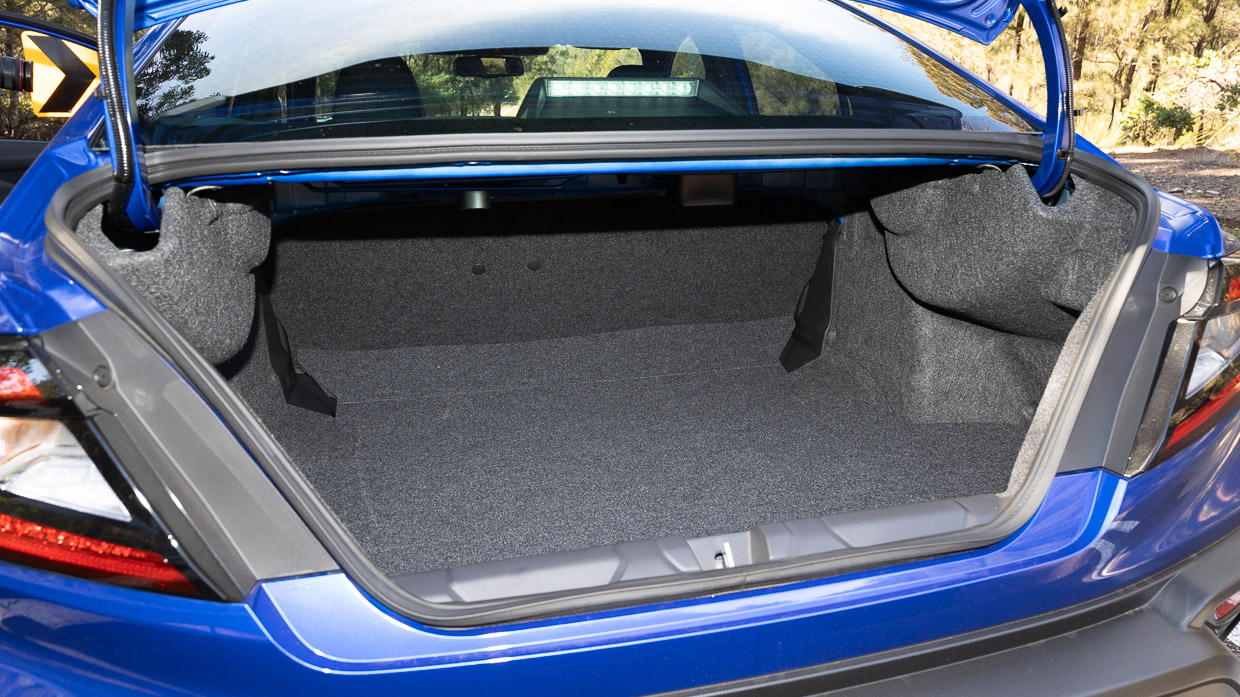
On that, the decent 411-litre boot is dwarfed by the 492L found in the Sportsback that converts to 1430 with row two stowed. No such convenience here.
A space saver is fitted under the WRX tS Spec B’s floor that appears sized to allow clearance for the large six-piston brakes used on the front axle.
While the last-gen WRX scored a five-star ANCAP rating and four of WRX’s stablemates — Crosstrek, Solterra, Outback and outgoing Forester — get full marks, the BRZ coupe and current WRX generation remain unrated.
There’s a broad array of features fitted to the model, though completeness is spec-dependent. Base versions lack Subaru’s EyeSight smarts, and some features, such as reversing AEB, are missing from manual variants.
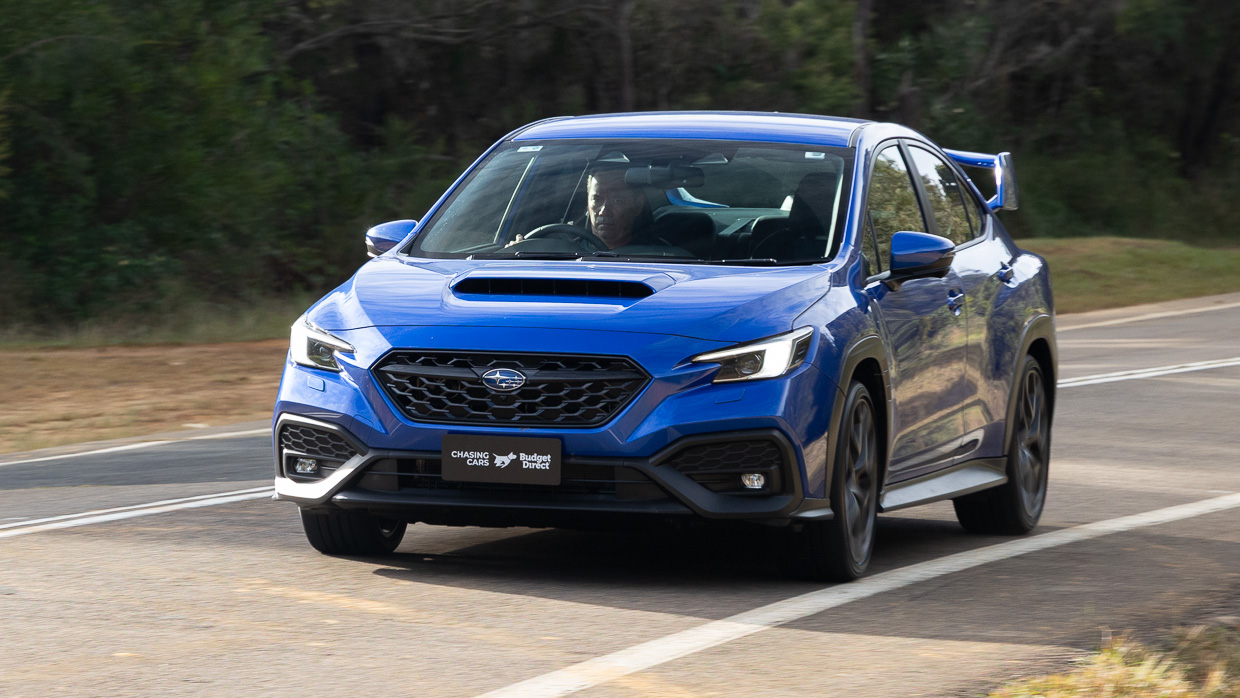
As it stands, the Spec B fits the following specifics:
The Spec B is, by 2025 standards, quite thirsty. The form guide suggests combined consumption of 10.4L/100kms, with an 8.2L highway figure and a sobering 14.2L urban claim.
Our test subject is not only around half-a-litre thirstier than the WRX RS manual sedan — for reasons that remain a mystery given it’s just one kilogram heavier — it drinks two litres per hundred more on a combined cycle and three litres more urban than any CVT sedan of Sportwagon variant.
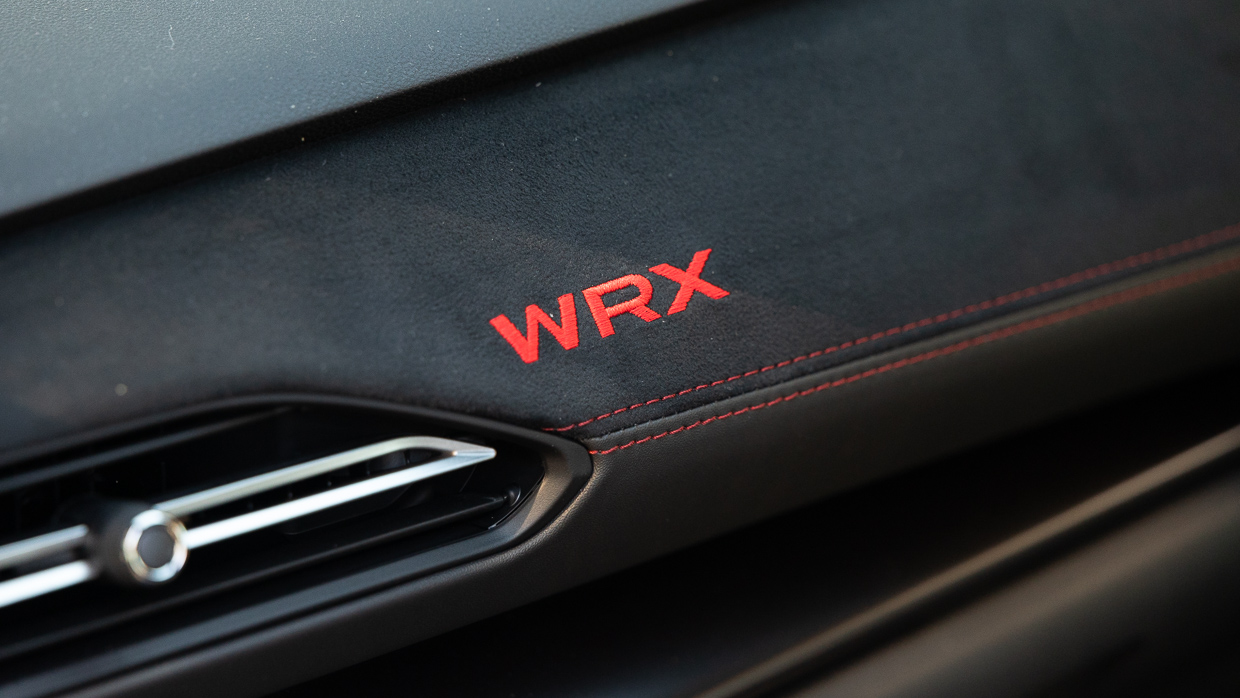
All WRXs demand a minimum of 95RON premium fuel.
Servicing will cost around $1370 upfront for a three-year plan and $2692 for a five-year plan, with intervals a typical 12 months or 15,000kms between visits.
Warranty is a fairly typical five years of unlimited-kilometre coverage.
Is it any good? Absolutely.
And given your reviewer had lost faith — especially in regular WRX stock — over a very long stint, the form of the fittest example of the latest generation comes as a bit of a pleasant surprise. The Spec B really is better than we were expecting.
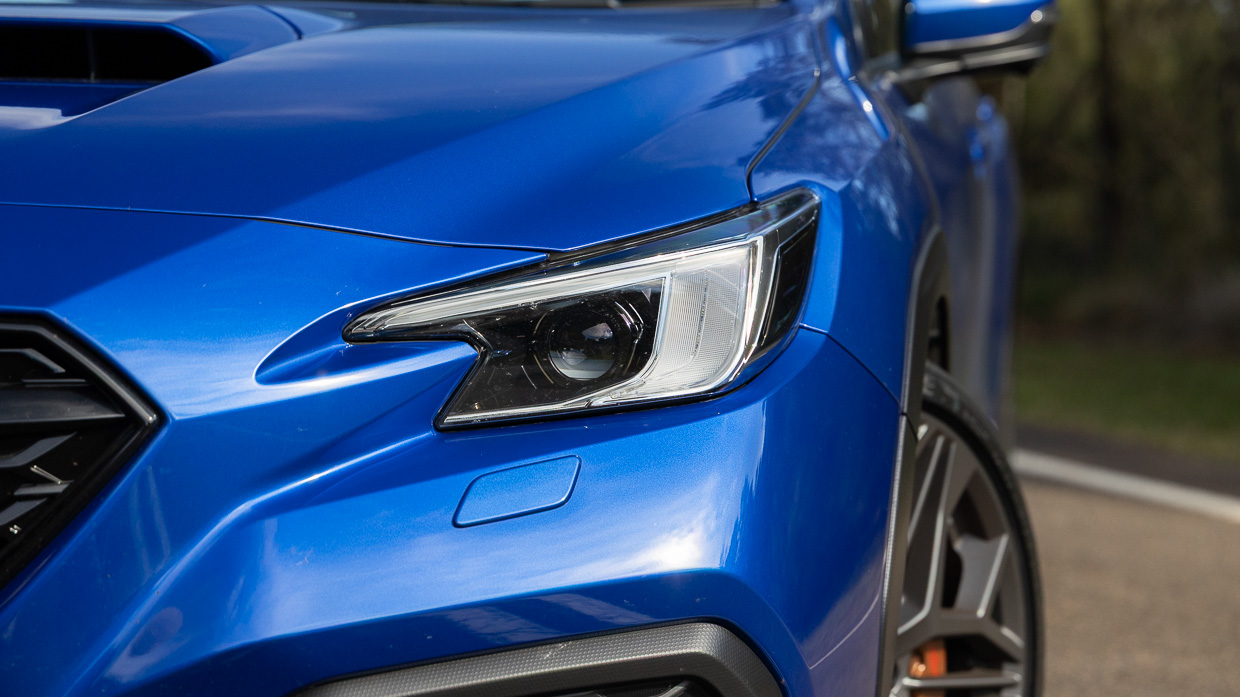
Is it anything like a classic STI experience? For strung-out red-misted talent, not really. But for back-road pace and solid fun factor in an endearingly old-school package with impressive new-school resolve, it comes much closer than anticipated.
Better yet, we cannot recall any WRX that’s nearly as fine an all-rounder while maintaining the soul that WRX had for so long traded off. If this isn’t the best WRX yet, it’s been a long, long time since Subaru has executed one this good.
Is it worth its premium? We’re inclined to think so.
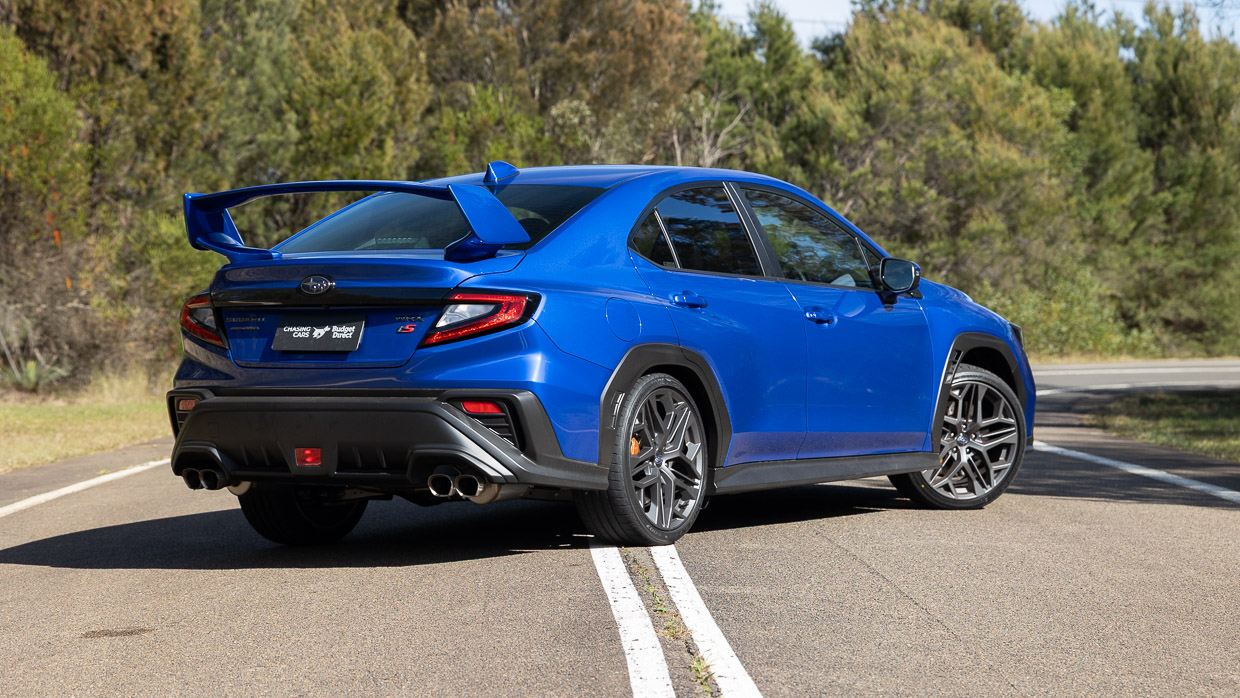
It’s a shame Subaru diluted some of the Spec B exclusivity by porting the Recaros and driver’s screen to all tS variants but…the other two options are no cheaper as a buy-in. And, besides, a real WRX deserves a proper manual ’box anyway…
Strike the tS Spec B up as a resounding win, especially for the gearheads among us who lament the shrinking landscape of conventional turbo-charged go-fast machinery.
Let’s hope Subaru can make it a trifecta by adding the illusive manual Spec B Sportswagon variant, and finding justification to once again cook up a pukka WRX STI.
Key specs (as tested)
About Chasing cars
Chasing Cars reviews are 100% independent.
Because we are powered by Budget Direct Insurance, we don’t receive advertising or sales revenue from car manufacturers.
We’re truly independent – giving you Australia’s best car reviews.
The estimate provided does not take into account your personal circumstances but is intended to give a general indication of the cost of insurance, in order to obtain a complete quote, please visit www.budgetdirect.com.au. Estimate includes 15%^ online discount.
^Conditions Apply
Budget Direct Insurance arranged by Auto & General Services Pty Ltd ACN 003 617 909(AGS) AFSL 241 411, for and on behalf of the insurer, Auto & General Insurance Company Limited(ABN 42 111 586 353, AFSL 285 571).Because we don’t know your financial needs, we can’t advise you if this insurance will suit you. You should consider your needs and the Product Disclosure Statement before making a decision to buy insurance. Terms and conditions apply.
Indicative quote based on assumptions including postcode , 40 year old male with no offences, licence suspensions or claims in the last 5 years, a NCD Rating 1 and no younger drivers listed. White car, driven up to 10,000kms a year, unfinanced, with no modifications, factory options and/or non-standard accessories, private use only and garaged at night.
^Online Discounts Terms & Conditions
1. Discounts apply to the premium paid for a new Budget Direct Gold Comprehensive Car Insurance, Third Party Property Only or Third Party Property, Fire & Theft Insurance policy initiated online on or after 29 March 2017. Discounts do not apply to optional Roadside Assistance.
2. Discounts do not apply to any renewal offer of insurance.
3. Discounts only apply to the insurance portion of the premium. Discounts are applied before government charges, taxes, levies and fees, including instalment processing fees (as applicable). The full extent of discounts may therefore be impacted.
4. We reserve the right to change the offer without notice.